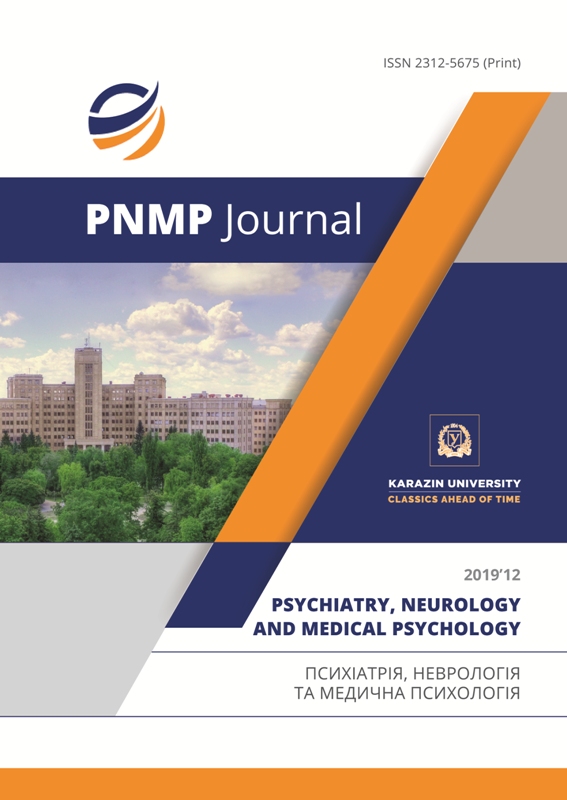Clinical-psychopathological structure of hallucinator-paranoid disorders during vascular dementia of heavy direction of expression
Abstract
The purpose of this study is to determine the clinical and psychopathological features of hallucinatory-paranoid disorders in severe vascular dementia.
The clinical and psychopathological structure of hallucinatory and paranoid disorders in patients with severe vascular dementia was studied in a group of 34 patients with mixed cortical-subcortical dysfunction with hallucinatory-paranoid symptoms — F01.3 (1-2), which consisted the main group. As a control group, the study involved 29 patients with severe vascular dementia (F01.3), without by hallucinatory-paranoid disorders.
To achieve the goal and objectives of the study, a set of research methods was used, including the clinical and psychopathological method, supplemented by the Behavioral Disorders Scale (Bahav-AD), neuropsychiatric questionnaire (NPI), non-cognitive sections of the AD assessment scale (ADAS-Non Cog) and methods of statistical data processing.
According to the results of the study, the following symptoms were revealed in the structure of hallucinatory-paranoid disorders in patients with severe vascular dementia: the prevalence of hallucinatory disorders over paranoid and paranoid disorders; the dominance in disorders of perception of frequent visual, auditory and tactile hallucinations of moderate severity; the prevalence of delusional beliefs that “the house is not his house” and the spouse/caretaker is impostors; the predominance of non-deployed, unsystematized and sketchy crazy ideas, that do not tend to expand; a combination of hallucinatory and paranoid disorders with frequent aimless activity of moderately strong severity; frequent generalized anxiety of moderate to severe severity; frequent sleep/wake rhythm disturbances of moderate severity; periodic moderate swagger; pronounced distractibility.
The data obtained should be taken into account when conducting differential diagnosis of patients with hallucinatory-paranoid disorders in severe vascular dementia.
Downloads
References
Levada O.A., Trailin A.V. Prevalence of psychopathological and behavioral disorders at the stages of development of subcortical vascular dementia in old and old age. Psychiatry and psychopharmacotherapy. P.B. Gannushkina. 2013. No 03. рр. 63-68. [In Rus.]
Mishchenko T.S., Mishchenko V.N. Vascular dementia. NeuroNews. 2011. - No 2/1. рр. 32-34.
Atherosclerosis, dementia, and Alzheimer disease in the Baltimore Longitudinal Study of Aging cohort / H. Dolan, B. Crain, J. Troncoso, S.M. Resnick, A.B. Zonderman et al. // Ann. Neurol. 2010. Vol. 68. рр. 231-240.
Bogolepova A.N. Population awareness of the problem of dementia. Journal of Neurology and Psychiatry. S.S. Korsakova. 2015. No 6. рр. 97-102. [In Rus.]
Korolʹ H.M. Multimodal approach to the diagnosis and treatment of vascular dementia. International Neurological Journal. 2014. No 6 (68). рр. 62-68. [In Ukr.]
Damulin IB Cognitive disorders in cerebrovascular pathology. "Medicine and Pharmacy News". 2011. No 5 (356). Access mode: http://www.mif-ua.com/archive/article/16362 (access date: 08/08/2018).
Maruta N.O. Mastering the updated system of diagnostic approaches and criteria for DSM-5: opportunities for professionals working in the field of mental health. Psychiatry, psychotherapy and clinical psychology. 2017. Vol.8 (1). pp.92-103. [In Ukr.]
Martsenkovsky I.A., Kazakova S.E., Martsenkovskaya I.I. Dementia as a comorbid pathological condition (view of the problem through the prism of cholinesterase inhibitor therapy). International Neurological Journal. 2014. No 4 (66). pp. 145-150. [In Ukr.]
Pinchuk I.Ya., Levada O.A., Cherednichenko N.V. Ukrainian adapted version of NPI and application experience. Archive of Psychiatry. 2013, Vol. 19, 3 (74). pp. 63-68. [In Ukr.]
Reisberg B., Auer S.R., Monteiro I.M. Behavioral pathology in Alzheimer’s disease (BEHAVE-AD) rating scale. Int. Psychogeriatr. 1996. Vol. 8 (3). рр. 301-308.
Pruszynski J. Non-cognitive symptoms of dementia. Medycznych. 2015. Vol.7. pp. 477-481.
Jacqueline K. Kueper, Mark Speechley and Manuel Montero-Odasso. The Alzheimer’s Disease Assessment Scale–Cognitive Subscale (ADAS-Cog): Modifications and Responsiveness in Pre-Dementia Populations. A Narrative Review. J Alzheimers Dis. 2018. No 63 (2). pp 423-444.
Antomonov M.Yu. Mathematical processing and analysis of biomedical data. – K., 2006. 556 p. [In Rus.]

